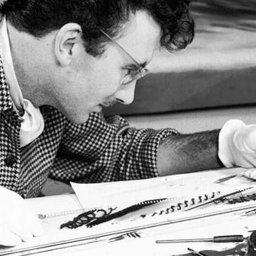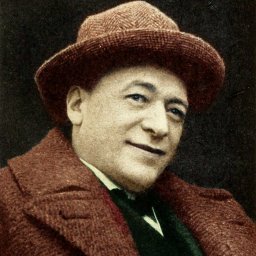Around is Around & Now is the Time
In 1950, McLaren made two 3D movies, Around is Around and Now is the time. Around is Around was based on imagery filmed by Chester Beachall from an oscilloscope, and Now is the Time was a combination of a hand-drawn figure in a world of paper cut-out clouds. Now is the Time had a card photographed music track, which was presented in eight-track wrap-around sound at the Festival. This was the first time McLaren has used his method of photographing patterns directly onto the soundtrack area. This new method gave him a chromatic range of five octaves and more tonal possibilities.
Neighbours, Two Bagatelles and Phantasy
In Neighbours, Two Bagatelles and Phantasy, all made in 1952, McLaren employed a technique which he had seen in some very old French movies, which he called Pixillation. In this technique, human beings were animated frame by frame like cartoon characters and performed impossible feats. For this, they used whole gamut of shooting speeds, from one frame every five minutes to one frame every 1/16th of a second, depending on the nature of the shot, so he would select the most desirable shooting speed. He often would vary speed in the same shot.
Neighbours is the winner of a Canadian Film Award . It was nominated twice in the 25th Academy Awards, for Short Subject (One-reel) and for Best Documentary (Short Subject). It was in the Documentary category that this short, stylized drama (with some comedic elements) won its Oscar.
Rythmetic, Le Merle, & Wonderful World of Jack Parr
During the second half of the fifties, McLaren made three films with paper cut-outs: Rythmetic (with Evelyn Lambart), Le Merle, and Wonderful World of Jack Parr (with Evelyn Lambart).
Short and Suite, Serenal and Mail Early for Christmas
In 1959, McLaren made three more scratched films: Short and Suite, Serenal on 16 mm film (with an electric vibra-drill) and Mail Early for Christmas.
A Chairy Tale
In 1957, McLaren and Claude Jutra made A Chairy Tale, (my favourite Norman McLaren movie) which was another Pixillation movie, technically more sophisticated than Neighbours, it also included manipulation of a chair with strings (as though it were a puppet). While rehearsing, he discovered that it was very important just where the strings were attached to the chair. Tying them low on the legs, or high on the legs, or low or high on the chair’s back, or to combinations of these parts, made possible very different types of chair motion. We had a variable speed motor attached to the camera, which could give us 16-, 12-, 8-, 4-, 2- and 1- frames per second (fps) depending on the effect required for the motion/behavour of the chair and the human actor. McLaren introduced the then strange Indian music to a larger Western public by having Ravi Shankar, Chatur Lal and Modu Mullick improvise music for the soundtrack.
Opening Speech
In 1962, these same lines were turned optically 90 degree to become Lines Horizontal. In fact, with horizontal lines, our minds read into their rising and falling motion the existence of gravity. Since the lines did not decelerate as they rose up, nor accelerate as they fell down, they seemed to float.
Lines Vertical
McLaren created Lines Vertical (1960), with Evelyn Lambart. In this, vertical lines only were animated by engraving directly with a stylus and a ruler onto black film. That is, by running the tip of a knife, sharpened like a tiny chisel, along a straight edge, the black emulsion was lifted off the film and a white line resulted. The formations used in the film were drawn on squared paper first. A lot of experimental drawing was done to find out which were the most effective and what form the film should take. Clear-lines-on-black were printed from black-lines-on-clear which again were negatives of the etched clear-line-on-black original. With a first pass in the optical printer, the negative was used with colour-filters to print the hues of the background onto colour-stock. In a second pass, the print (clear-lines-on-black) was used without filters to burn in out white lines.
Lines Horizontal
Another movie with similar effect is Opening Speech (1961). All shots where there is lip-synch speech, were made with normal camera and sound recording equipment and the movement of the misbehaving microphone was controlled either by off-screen human hands, mostly by black nylon fishing tackle (invisible to the camera) attached to the microphone and manipulated off-screen. In shots where there is no lip-synch speech, they used a camera with a variable speed motor. This allowed to shoot many scenes at 12- or 8-frames-a-second, for more precise control of the microphone’s action; he would slow down his own performance correspondingly. He also used stop motion for some scenes.
Spheres
Spheres, originally shot in 1948 with René Jodoin, was released in 1969. In this, the “spheres” were moveable cut-outs; each was a thin flat metal disc painted to look like a sphere. Theses discs were animated frame by frame on a block card, upon which their paths and motion had been pre-calibrated faintly in dark red pencil, which was invisible to the camera. This was superimposed on panning and travelling pastel backgrounds.
Mosaic
In 1965, Mosaic was produced from a combination of Vertical and Horizontal; white-line-on-black background copies of both films were printed in contact with each other, revealing only small dots at the intersections of the moving vertical and horizontal lines. This was done by running a clear-on-black copy of both vertical and horizontal in contact with each other, in an optical printer. McLaren and Lambart then coloured the dots optically. Apart from the human whistle at the beginning and end of the film, the rhythmic soundtrack of Mosaic was made by direct engraving on 35 mm black emulsion-coated leader. The black emulsion was scratched off with a knife or needle to leave occasional small clear marks; such scratch-marks, when run on the optical soundhead of a moviola or projector, produced percussive sounds. Variations in the size and shape of the scratched marks affected the pitch, volume and quality. In this way a variety of clicking, thumping, thudding, and rasping sounds were produced.
Synchromy
In Synchromy (1971), McLaren used what he called as Animated Sound for the last time. He called it so, because it was shot frame by frame, onto the soundtrack area at the edge of the picture. For pitch control a set of 72 cards was used, each having stripes or striations, and each representing a semi-tone in a chromatic scale of six octaves. The more stripes the higher the note, the less stripes the deeper the note. The volume was controlled by varying the width of the soundtrack. A moveable shutter controlled this width. If the shutter was almost closed, the extremely narrow band of striations would give a pianissimo note. If the shutter was wide open, the broad band of stripes would give fortissimo. All intermediate degrees of volume were possible by regulating the position of the shutter, which was calibrated in decibels. The music was composed first, and filmed by this method. To create the visuals the three-striated card soundtracks were kept separate and in their striated form. By means of an optical printer they were moved over into the picture area of the film. So what is on the screen, be it in one or several columns, is strictly the striated images of the original sound shot with cards. Thus, there is exact parallelism between sound and image. Variety was given to the visuals by frequently changing the track positions from one column to another. In general the colouring was changed at the beginning and end of musical sentences or phrases for variety’s sake; although no “colour-sound-theory” was relied upon, pianissimo passages were usually in mutes hues, and fortissimo passages in highly saturated contrasting hues. Apart from planning and executing the music, the only creative aspect of the film was the “choreographing” of the striations in the columns and deciding on the sequence and combination of the colours.
Norman McLaren spent almost all of his life making animations, experimenting various possibilities. He invented many new techniques, improved many existing ones and explored their potentials. But his reasons were simple enough. He once said, “I have tried to preserve in my relationship to the film, the same closeness and intimacy that exists between a painter and his canvas… and so my militant philosophy is this: to make with a brush on canvas is a simple and direct delight – to make with a movie should be the same.”
This view of animation as an art of personal expression, even within the context of an institution has an enormous influence on animation universally. It is no exaggeration to say that Norman McLaren has played no small part in the worldwide development of both documentary and animation cinema. His contribution to animation is tremendous; animation today might not have been the way it is without Norman Mclaren.







